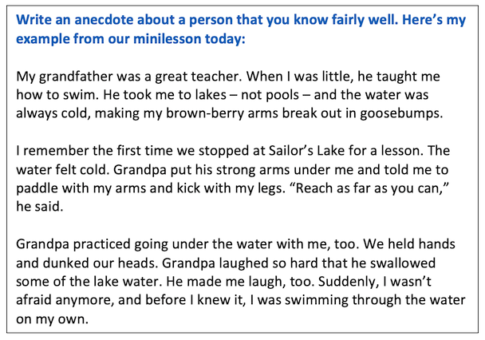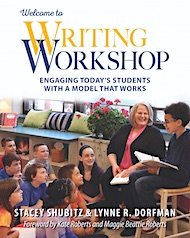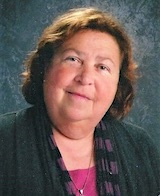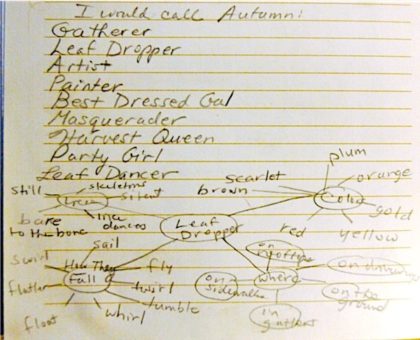Reclaiming the Power of Writer’s Notebooks
A writer’s notebook is my superpower as I travel from classroom to classroom to observe, coach, and participate in writing workshops. Or visit Italy. Or head for the grocery store.
When we keep our own notebooks and make writing in them a regular practice, we’re much better prepared to teach our students the value of capturing and storing away our thoughts for future use. Let’s talk about our own notebooks first.
Save Your Notebooks!
I usually have two to three notebooks with me as part of my writing workshop toolkit, including the current notebook I am writing in and one or two favorite notebooks I have filled from cover to cover.
One of the most important practices I want my students to adopt is to revisit their writer’s notebook to find possible topics to write about. Notebooks can also yield up ideas for organizational scaffolds and craft moves they’ve studied and are ready to imitate – including interesting sentence patterns and sophisticated uses of punctuation.
I still have most of my “completed” notebooks stored in a roll top desk with deep drawers. I return to them often to reread and be inspired. Sometimes, I find myself saying, “Wow! Did I really write this?” Other times, I review the pages I have marked with a capital “R” and highlighted or tagged with a sticky note. These are my reference pages – notes that help me understand more about a strategy or issues of grammar or conventions. Often they become a place to store my thinking about a writing solution to a problem I’ve encountered.
In the age of portable technology I continue to write most of my first draft material with a pencil or pen, keyboarding only after a complete draft has been hatched. I find there is something magical about putting pen to paper. It is electrifying – charging me to spill words onto the page! I love to write ideas down in different colored pens and watch the words pour into the notebook. It’s both comforting and energizing to watch the steady flow of thoughts race from page to page.
I find there’s nothing better than to curl up on a chair in the den or sit on a dry, grassy spot in my backyard and write. Airports, classrooms, dog walks, garden strolls, city parks, even supermarket trips inspire writing.

I use my notebook to write about people, celebrations, and objects that I love or enjoy or that I find unique in some way. My notebook is filled with snapshots of friends, relatives, and pets. Rich descriptions of Long Beach Island, the Poconos, my grandma’s house in Emmaus or Coopersburg, the stables, and my East Mt. Airy neighborhood are some of my favorite entries.
Two summers ago, I filled a notebook with entries about my trip to Italy’s Amalfi Coast with my husband and friends. My sketches and photos helped to bring new energy to my words. Seeing them again now reminds me to continue to use photos and sketches to inspire more writing.
And I love sharing the writing, sketches, and photos with my students because it is important for them to see me as a writer – not just a teacher who teaches them about writing. When they begin to understand that I am a writer, too, they are more willing to share with me and accept me as part of their writing community.
The Notebook Is a Place for Lists
My notebook is always a place to store lists as a pre-writing strategy. For example, after reading Names for Snow by Judi K. Beach I had the urge to brainstorm a list of names for autumn. I came up with names such as Leaf Dropper, Party Girl, and Best Dressed Gal.
I love making lists because they often help me find a topic I want to write about or research. As I look at the notebook page below, I would add Sienna Surprise and Memory Maker since autumn inspires so many happy memories. One of mine is playing hide-and-seek in the enormous leaf piles my grandfather created on his front lawn in Coopersburg or going on haunted wagon rides in our own Sleepy Hollow in late October.
Click to enlarge
My notebook is a place for memory chains, my heart and hand maps, and my neighborhood maps. A running theme in all my notebooks is my grandfather. Often, I revisit my notebooks, and I am always surprised to see so many entries about him. He is like a very deep well where I can go to quench my thirst over and over again. I keep my lists, memory chains, and maps in the back of my notebooks. I advise my students to start at the back of their notebook to store all their prewriting strategies so they can be easily accessed.

I could not imagine a writer’s workshop without the notebook as a central part of how writers live their daily lives. I am grateful to Ralph Fletcher, Aimee E. Buckner, and Katie Wood Ray for all their advice and inspiration they have provided in their professional publications about writer’s notebook!
Have Kids Practice Craft Moves at Home
We need students to add to their notebooks when they are at home and throughout the day. Sometimes, you can have writing as homework – where students can try out a new strategy they’ve learned in class in their notebooks. Since you want to encourage experimentation, give this assignment a certain number of points for effort, but don’t give it a grade.
I suggest choosing one day of the week for this kind of notebook writing, and target the same day of the week, if at all possible, throughout the semester or year.
✻ Predictable problem – Some students will leave their notebooks at home (or at school).
✻ Easy Solution – Have students write their entries on loose leaf or tablet paper and staple it into their notebooks the next day.
Give students a general topic – a person, place, or thing to write about that helps them focus. Or write a notebook entry around the minilesson of the day. You could share a model on your class website to get students started at home. This would also help parents know what you’ve been doing in writing workshop.
Keep it simple – connect to new learning in class or use the entry to reinforce an important writing strategy. Create a possible menu for what your students could try out at home for writing. Be sure to create a mentor text with your own writing to help your students be successful.
The writing assignments with examples will help your parents know what your students are learning about in writing workshop at your grade level. Parents will start to understand that students are learning about grammar and conventions, but they’re also learning about how to build quality content, improve sentence fluency, use a variety of organizational structures, find their voice, and make every word count.
Some Final Thoughts
Students should be able to choose their own writer’s notebooks and personalize them with photos, artwork, fabric – whatever makes the notebook unique for them. I’m not particular about brands, only size; specifically, whether they will fit into a pocket or my purse, and how much I can get on one page.
I usually buy a spiraled notebook because it lies flat on a writing surface when opened. Sometimes, I find myself making notes on the back of sales receipts, envelopes, junk mail, whatever is lying about. All these scraps eventually end up taped or clipped into my writer’s notebooks.
A writer’s notebook is a place to connect your emotions – what makes you angry, sad, and amazed – to events in your life. A notebook accumulates its value slowly, line by line, and page by page. When you begin a notebook, you don’t know what will prove to be a dead-end and what might be the inspiration for a writing project, a poem, an essay, or a memoir.
A writer’s notebook is a place to write down what you notice and don’t want to forget; a place to record your reactions to things. Most of all, it’s a place for students to take everything they’ve learned in writing workshop and make it their own. It’s a place to live like a writer.

Lynne is currently finishing her eighth book for Stenhouse Publishers, Welcome to Reading Workshop. She also welcomed Rosie, a seven-month-old Welsh Corgi pup, into her home on July 4th. Surely, there will be notebook entries about her!






































